How Whites on the Frontier Forged a Common Identity
Robert Hampton, American Renaissance, February 2, 2021
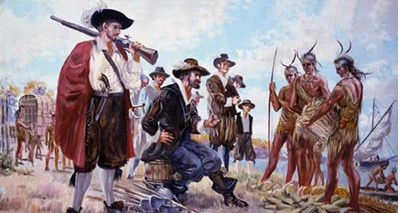
Peter Silver, Our Savage Neighbors: How Indian War Transformed Early America, W.W. Norton, 2008, 432 pages, $21.91.
The frontier defines America. Historian Frederick Jackson Turner famously asserted: “American democracy was born of no theorist’s dream; it was not carried in the Susan Constant to Virginia, nor in the Mayflower to Plymouth. It came out of the American forest, and it gained new strength each time it touched a new frontier.” Turner believed the frontier severed the settlers from their European roots and created a new people.
Princeton historian Peter Silver agrees. However, his 2008 Bancroft Prize-winning book, Our Savage Neighbors, emphasizes the people of the wilderness rather than the wilderness itself. The book is mainly about the middle colonies in the mid-to-late 18th century, and argues that Indian attacks forced Europeans of different backgrounds and faiths to unite against a common foe. The Indian threat created a shared white identity: “In the face of contact with other populations, members of some groups came to suddenly see new kinships with one another — kinships that became easy to perceive only when they had a reason to imagine themselves as they must look through another group’s unfriendly eyes.”
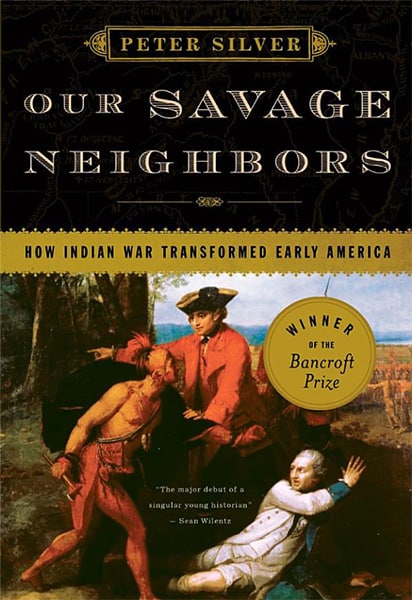
As Prof. Silver writes: “Anyone who professed to not see the dangers [of the Indian threat] . . . or who seemed not to care enough about the suffering it relentlessly described, was open to the charges of acting against the best interests of the new group, more and more often invoked in the middle colonies after midcentury: ‘white people.’” Prof. Silver finds that during the French and Indian War, the Pennsylvania Gazette increased its use of the term “white people” to distinguish settlers from Indians. In 1756, 77 percent of articles about Indian attacks used the term. The next year, the number rose to 92 percent and remained around that figure throughout the war.
The characteristics of this colonial white identity were, according to Prof. Silver, “first, of embodying an overall opposition between Indian and European interests; second, of invoking the great suffering of the great bulk of rural Europeans at Indians’ hands; and third, and most crucially, of providing a standard of loyalty against which individuals’ actions could be judged.” This standard showed white elites in a negative light, since they seemingly favored the Indians. In pre-Revolutionary times, the traitorous elite in the eyes of Pennsylvania settlers were the Quakers. Many ignored the savagery of the frontier and protected Indians from retribution. In the years leading up to the Revolution, British authorities also appeased the Indians by trying to restrict European settlement.
Prof. Silver rejects contact theory, which claims that exposure between groups reduces prejudice. The opposite occurred on the Pennsylvania frontier: “Living together made the different sorts of people there feel frightened of one another’s intentions. Forced proximity brought many groups to a fresh appreciation for their own distinctive ways, ways they thought of as ‘traditional’ and fought to recover amid the disturbing novelties that came with diversity.”
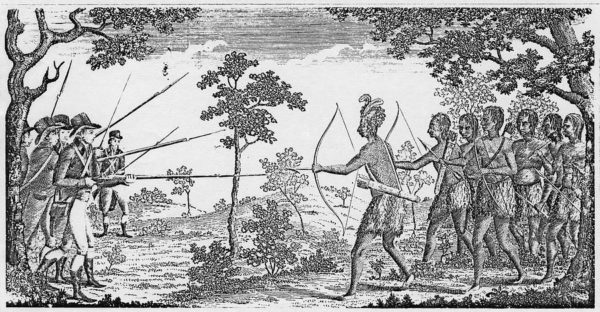
Prof. Silver assures his readers that “modern” racial thinking had no influence on 18th-century people. This sentiment, according to the author, emerged only in the 19th century — a curious claim for a book on racial conflict. While the settlers may not have used modern language, they could tell who was like them and who was not. They understood that people who looked like them but spoke a different European language were more similar to them than Indians who spoke English.
The Pennsylvania backwoods were filled with many different European nationalities. Germans, English, Scots, Irish (mostly Ulster Scots), French, and even a few Scandinavians settled on the frontier. There was an equally wide array of faiths and creeds. Some settlers belonged to pacifist denominations, such as the Moravians and the Mennonites that were sympathetic to the Indians. Others were Catholic, which elicited hostility from the other colonists. The two largest groups on the midcentury frontier were the Germans and what Prof. Silver calls the Irish. These two groups didn’t speak the same language, nor were they of the same denomination. Both groups were suspicious of each other and competed for political power. Many in the colony wanted the Germans to have virtually no political rights, and many English-speakers though it was scandalous that Germans could sway elections. Nevertheless, these groups and others were able to see themselves as one people in the face of Indian savagery.
Prof. Silver neither sugarcoats Indian atrocities nor excuses their attacks as a defense against “colonization.” He writes of Indians abducting children and dismembering them in front of horrified white captives. Indians showed no remorse for such acts. The point of these atrocities was to terrify the Europeans into leaving the frontier, but for many Indians, torture was part of their way of life. Indians tortured enemy tribesmen. They targeted white women and children to terrorize the settlers. This was ethnic cleansing, a crime usually attributed only to white settlers. It occasionally worked, and refugees fled eastward after devastating Indian attacks. However, Europeans were too numerous and land hungry to abandon the frontier.
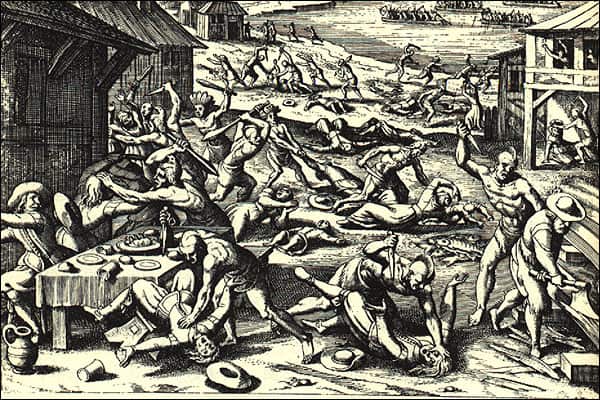
An Indian attack on Jamestown in 1622.
The author describes European reactions to Indian attacks ungenerously, suggesting that the settlers were cowards. He claims Europeans were paralyzed by fear and offered little resistance when Indians descended on homesteads. Prof. Silver cites only a few cases to justify this claim. One is of a young boy who did nothing while Indians carried away his brother. The child’s terror is hardly surprising, since he faced hardened warriors.
When Europeans retaliated, Prof. Silver paints them as dishonorable. Nearly every European aggression described in the book is of whites punishing innocent Indians. Prof. Silver recounts several incidents in which whites got Indians drunk and then murdered them. There are other stories of Europeans slaughtering traveling Indians and militias destroying the villages of Christian Indians. The author gives the impression that whites never fought fair and killed only easy targets. He condemns these acts more harshly than he does Indian atrocities.
Militia violence against supposedly innocent Indians won support in the backwoods but not in Philadelphia. The eastern metropolis would occasionally offer protection to Indians fleeing frontier violence, which further alienated the population from colonial leaders. Backwoodsmen sometimes threatened to march on Philadelphia and wipe out all Indians under its protection. The frontier press excoriated Quaker leaders as traitors to white people. In turn, the colony’s elite — including Benjamin Franklin — called the frontiersmen “Christian white savages” who were no different from the heathens. Franklin, who famously attacked German immigrants as swarthy aliens, argued the frontiersmen hated the Indians only because “they had a reddish-brown Skin, and black Hair.” Franklin, however, was not a Quaker and was less pro-Indian than the dissenting Protestants who led the colony.
Anti-elite sentiment carried over to the British after the French-Indian War. The British prevented European settlers from going West and protected Indian tribes. During the Revolution, the British allied with Indians and encouraged attacks against settlers. The Patriots leaned heavily on solidarity against Indians to draw support for their cause. Prof. Silver highlights the anti-Indian passages in Thomas Paine’s Common Sense, arguing that he found “the most useful image [for persuasion] of all was that of Indians and Indian-style violence.” The recollection of the savage tortures dealt by the British and their Indian allies helped separate the colonists from “the Crown they had loved and served from a distance for more than a century.” Anti-Indian rhetoric helped create a new national identity for the colonists. The shared suffering of the European settlers made them one, and justified rebellion against the Crown.
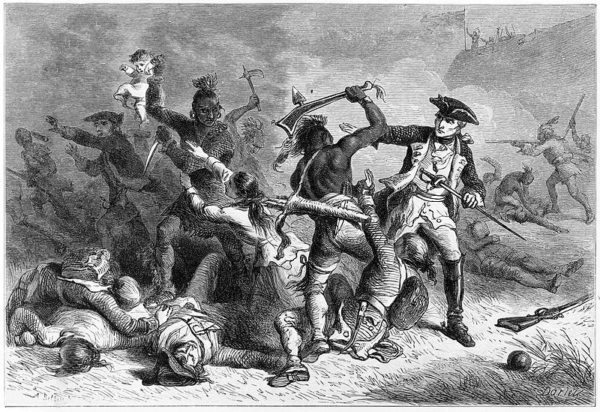
The Battle of Fort William Henry during the French-Indian War. (Wood engraving by Alfred Bobbett, based on a painting by Felix Octavius
Prof. Silver argues that this national character led to a more “tolerant” national character: “The crises of Indian war had tilted the public life toward the celebration of a suffering people, creating a new politics that was harsh and ruthless, if recognizably democratic,” and this democratic character allegedly caused the new Americans to end religious and ethnic bigotry. This is an odd claim. The popularity of the Know Nothings in the 19th century, for example, does not represent a nation that ignored these differences.
European Americans founded a common identity based on race in the face of an alien enemy. These foundational Americans kept this identity well into the 20th century. Only after the Second World War, with Indians relegated to the past, did white Americans lose touch with their nation’s foundational identity.
Our Savage Neighbors is relentlessly progressive in its treatment of white settlers, endlessly retelling stories of cowardly white settlers either fleeing from attack or slaughtering peace-loving Indians. However, Prof. Silver’s book does dispel contemporary myths about American identity and heritage. The settlers who revolted against the British were not a collection of individuals who came together solely to fight for abstract principles. They were Europeans molded into one people by the barbarities of the frontier. A shared enemy united them and distinguished them from other peoples. This commonality was not equal rights or natural law. It was race.















